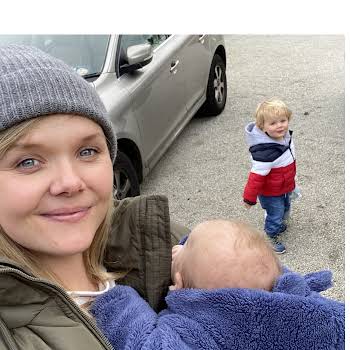
‘It was hard enough to be a new mum without having the shame of wetting myself’
Post-birth incontinence isn’t just physically difficult to come to terms with, but emotionally, it marks an indignity and embarrassment that is rarely discussed. Amanda Cassidy speaks to those who have experienced such problems after childbirth.
It’s fair to say that nothing will ever be the same again after you bring a child into the world. You have created a new life in the form of this pink, velvety, screechy creature you can’t let out of your arms — in that instant, all your priorities shift as you devote yourself to keeping your baby happy, safe, loved.
But what many women don’t realise as they emerge from the fog of the delivery, is the physical effect that giving birth has on your body. And some of those are lasting.
Related: Pelvic floor dysfunction: All you need to know
I have the scars from three c-sections, a bittersweet reminder of the days my three babies arrived into this world. Others might boast stretch marks or skin tags, blue veins or larger feet. We are taught to look out for depression, anxiety or feeling overwhelmed. But these pregnancy and birth-related side-effects are well discussed. It makes sense that we are more prepared for the things we are aware can happen.
The women we spoke to about things like pelvic organ prolapse, anal and urinary incontinence all told us the same thing: “we were not prepared for it and that made it worse”.
“The majority of births are straightforward and uncomplicated.”

Kegels
There is a fine line between frightening those who have not yet experienced childbirth with horror stories and being honest about what lies ahead. The majority of births are straightforward, uncomplicated and uneventful – hardly the material for dramatic story retelling. But there are elements that would benefit women to mentally prepare themselves for.
We have all heard of ‘doing your Kegels’ (also called pelvic floor exercises) and the importance of keeping them strong. It is because the tissues and muscles that support your uterus, bowel and bladder stretch out during pregnancy. It is as a result of hormones as well as the increasing weight of the baby.
During birth, the pelvic floor muscles stretch and weaken even more — this weakness makes it more difficult to control the small muscles at the bottom of your bladder which means you might have trouble controlling when you pee. It is medically referred to as stress incontinence and is very common in new mums. (It can affect about a third of women in the first year of having a baby).
Socially bothersome
“I felt quite alone and I was mortified because I couldn’t come out and say, well… I pee my pants every day”.
You might hear those who have children joke about not being able to use a trampoline for this very reason. Similarly, many of us still have to cross our legs when we sneeze. Often it is just a few drops, but some women can regularly soak their pants. Using a pad can be helpful, but over time, this can become becomes quite a bleak problem for women.
Martina had a large baby and a long delivery. Her son was delivered with the help of forceps — instruments designed to help the baby out of the vaginal canal.
“I leaked pretty consistently for 10 months, not just spritzing but enough that I had to wear a pad every day. It was hard enough to be a new mum without having the shame of wetting myself. I couldn’t talk about it because none of my friends had such sensitive issues — their problems were mostly a lack of sleep or trouble with breastfeeding, I felt quite alone because I couldn’t come out and say, well, I pee my pants every day. It really got me down. The indignity of wetting myself every day was a lot to deal with.”
Trapped
Ann, a mum-of-two from Dublin, had a third-degree perineum tear while delivering her second son (a tear of the muscle downwards from the vaginal wall to the anal sphincter, the muscle that controls the anus.) “In the first few days after giving birth, I would stand up and it would just empty out. I was going through nappies faster than my son. I’d do my pelvic floor exercise but they were just too weak to stop the urine flow.”
“I’d love to see more women talking about it”.
Ann said she didn’t know this could happen. “I knew you might leak a little when laughing, but I had no idea my body could let me down like this, in such an embarrassing way. I stopped going out, I felt trapped at home and to be honest, I felt like a freak. My doctor kept saying ‘do your Kegels,’ but it wasn’t until I was referred to a specialist that I realised how much damage had been done.”
Two years later, Ann has had scar tissue removal surgery and is attending a pelvic floor physiotherapist. “It is so much better. I am building back up control and it is now rare that I leak at all. Sex is no longer painful like in the months after birth. It takes a bit of getting used to because the physiotherapist really gets ‘up there’. But my confidence is definitely returning. I’d love to see more women talking about it.”
Amy Rosenman is a doctor at UCLA specialising in female pelvic medicine. “As part of the extraordinary forces on a woman’s body during delivery of the baby, the pelvic tissues may be subjected to damage. As the head comes out, the forces can actually tear the ligaments that anchor the pelvic supporting muscles to the pelvic bones. The muscles themselves may also be damaged. Sometimes the muscle near the outside of the vagina is intentionally cut by the doctor to help speed up the delivery.
For some women, these damaged muscles and ligaments remain weak and do not entirely heal. As time goes on and the normal changes of ageing and weakening of the tissues take place, incontinence may result”.
Natural force
Rosenman believes that controlling certain aspects of birth should be prioritised. “Recent studies show that the likelihood of incontinence and prolapse is lower if the mother (and her doctor) allow the natural force of the uterine contractions to push the baby down the birth canal, rather than have the mother push as hard as she can during this time. If the voluntary pushing part of labour can be limited to less than one hour, studies show a lower incidence of injury to the nerves and muscles of the pelvis.”
In other words, finding a more natural way to deliver by letting the body do the work it was designed to do in its own time. Avoiding vaginal birth might seem tempting. A study published in Obstetrics and Gynecology found that new mothers who delivered vaginally are more likely to have urinary incontinence one year postpartum compared to women who had c-sections.
But c-sections come with their own risks – a planned c-section increases the baby’s risk of needing emergency care and the mother’s risk of developing blood clots, bleeding, as well as uterine rupture and problems with the placenta in future pregnancies. Many associations with post-partum incontinence are also genetic. Often the general wear and tear that comes with having delivered a child equalise over time, meaning that gravity, age and weight can mean that no matter how you deliver, you might end up with leakage in later years. Oh, the glory of motherhood.
Hedging your bets
So is it a case of choosing the lesser of two evils? And why are we not as open about this aspect of childbirth? If we can’t prevent the damage that causes postpartum urinary incontinence, it is reasonable to attempt to mitigate the damage by offering pelvic rehabilitation, including enhanced information about healthy bladder habits and teaching with reinforcement regarding muscle training.
Prevention
Try these at home.
Kegels: Lie down, knees bent and legs parted. Tighten the muscles around your vagina and urethra as if you’re trying to prevent urine from leaking out. Place one hand on your lower tummy and make sure you’re not pushing or contracting your tummy muscles (If you’re pushing down on your abdominal muscles or squeezing your thighs or bum, you’re not doing the Kegels correctly.) While breathing, tighten your vaginal muscles. Think of the pelvic floor as an elevator: Contract muscles in stages, rising to successive levels slowly, in intervals of five to ten seconds. Aim to accomplish sets of ten, three to four times a day, every other day.
Lifestyle changes: Cut down on alcohol, fizzy drink, spicy food and coffee which can irritate your bladder and make it contract more easily. Smoking can affect the muscles of the bladder causing it to spasm. The coughing associated with smoke inhalation can also wreak havoc on your pelvic muscles. Any extra weight you are carrying can also put constant pressure on those muscles.
Stigma
At the very least, we should have the option to have healthy, upfront conversations with our doctors, gynaecologists and caregivers about what to really expect physically during childbirth; the good, the bad and the ugly. This way we can prepare successfully for the more challenging aspects that come along with the badge of motherhood.
Image via Unsplash.com
Related:
Read more: How much water should we be drinking?
Read more: Why do babies and bumps give people a licence to judge?
Read more: Pregnancy Diaries: It is finally time to tell people.























